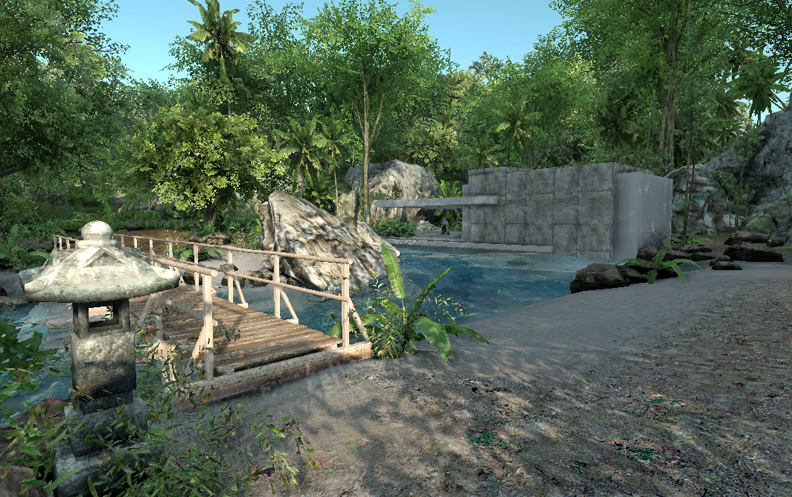Traditional suburban homes, single family wood built house, generally lack enough insulation to keep heating and air conditioning bills reasonable. To keep an older home feeling comfortable, one has to use more energy (electric, oil or gas) or add insulation. Energy Savings: Best Wall Construction explores the options.
Energy Savings: Best Wall Construction compares how houses were built and how they can be improved. We also review how framed homes should be constructed, and lastly, how they should ideally be built.
Type 1: Existing Typical Wall for a Suburban House
In our first example, wall system integrates Structure, Insulation, Cladding, Interior Finish and Electrical into one compacted space. This is generally what homes across America look like, with a few variations like adding a brick veneer. Depending on the age of the house, the insulation can be between an R-3 to an R-13, using batt insulation. See our guide on insulation and explanation of R-Values here: INSULATION: Everything You Need To Know.
The diagram below shows an integrated wall system including footing, foundation wall, concrete slab, and stud wall filled with insulation.
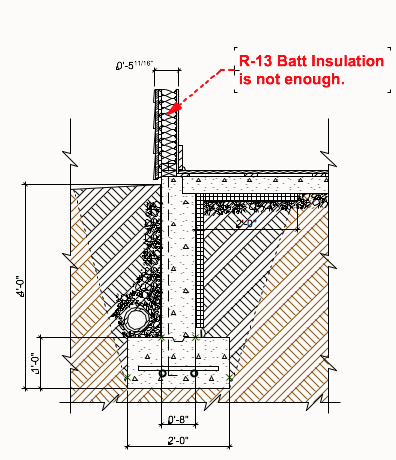
Brick Note: brick cladding (one layer of bricks over a stud wall structural system) has its sole purpose as providing an aesthetic look. It has no structural, insulation, or other properties and can trap moisture between it and the house framing, i.e. it is fake as it tries to trick the viewer into believing the house is a masonry structure.
Pros & Cons of Type 1, Integrated Wall System:
CONS of the Existing Stick-Built Wall System:
- Insulation isn’t continuous and studs transfer heat/cold.
- Electrical is harder to upgrade if expandable foam is used instead of batt insulation.
- Trades take more time to integrate their components into stud system.
- No solid masonry to eliminate wind forces.
- Noise transmittance is poor.
- Outlets are not insulated areas of the assembly.
- Rough-in plumbing is a no no on exterior walls, to prevent freezing pipes.
PROS of the Existing Stick-Built Wall System:
- System takes up less floor area. This can be relevant in urban areas where zoning counts the overall Gross Square Footage. As a result, more buildings are being built with very thin exterior walls in order to make habitable spaces larger. This system of measurement must be changes to allow for more robust and sustainable buildings to be built.
The wood floor would likely be vinyl tile, often contaminated with asbestos if installed before 1975.
Asbestos floor tile can be covered (encapsulated) with newer vinyl tile, wood flooring, engineered flooring or carpet, or left alone. Only when it is chipped or broken does it pose a moderate danger of exposure to asbestos.
Type 2: Enhancing Typical Wall for a Suburban House
There are several ways to upgrade insulation on an existing home. Here are some examples:
- GUT RENOVATIONS: If doing a gut renovation where the wall board is removed, one can easily remove the old batt insulation and add expandable spray form insulation. At around an R-5.5 per inch, the 3.5″ cavity will give you an R-19.25, seal up any air leaks and give vapor protection. Be sure to upgrade all electrical lines and getting to them after one foams will be near impossible.
- KEEPING THE EXISTING WALL BOARD: If you’re able to remove the existing batt insulation without remove most of the wall board, then you can spray in cellulose insulation. If the wall board is to remain, and there is no insulation, filling up the stud cavities is easy with just a couple of holes in the wall. If there is batt insulation and it isn’t attached to the studs (i.e. it doesn’t have a vapor barrier attached to the studs) then consider removing about 1 foot of sheet rock near the floor and then pulling the batt insulation out, then adding blown-in cellulose insulation.
- KEEPING INTERIOR UNTOUCHED BY ADDING INSULATION TO THE EXTERIOR, See Diagram below:
Lets look at Option 3 closer, as it makes the most sense for those needing to upgrade their R-Values. It is also a good option for upgrading the appearance of the typical 1960/70’s styled ranch house.
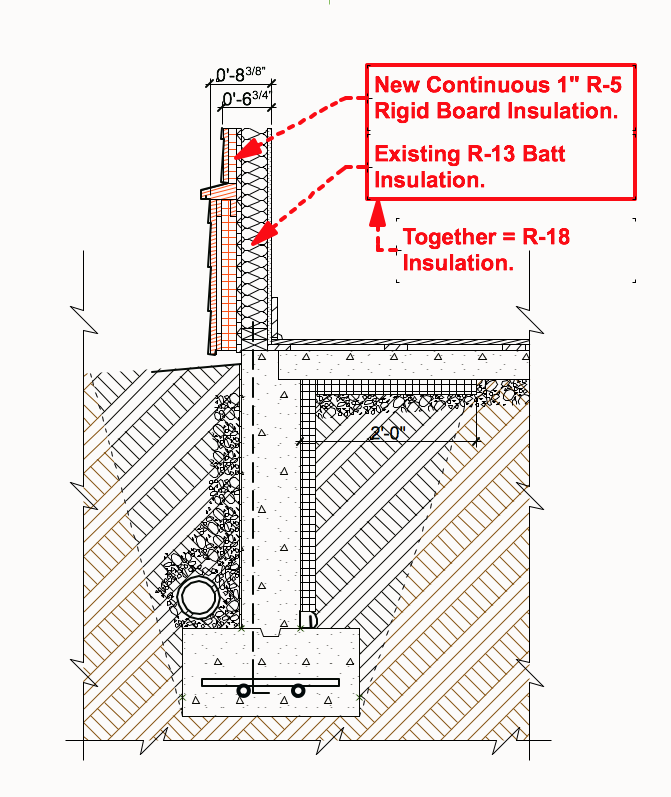
Type 2-Cladding:
Cladding: Use fire-resistant fiber cement boards with manufacturers recommended backer board. They come in a variety of styles including horizontal lap siding for a traditional look. It gives a Class 1(A) which is the highest fire spread rating possible. A good article on cement board is here: https://architizer.com/blog/product-guides/product-guide/eaktna-fiber-cement-cladding/
Vinyl siding will burn, so avoid it. Instead use aluminum or other recommended finish if budget is a significant issue.
Type 3: New Construction Using 2×4 Framing
Generally speaking, contractors will continue to use 2×4 framing for the vast majority of single family housing. While there are some projects that use 2×6 framing in conjunction with R-18 Batt Insulation, this method increases the cost of the framing both in material and labor and isn’t as thermally effective than what we are proposing here, so we will focus on 2×4 stud structural walls.
While our goal is to be above an R-20 for walls, totally passive houses are R-40, so this construction method could be enhanced by doubling the thickness of insulation to offer maximum protection.
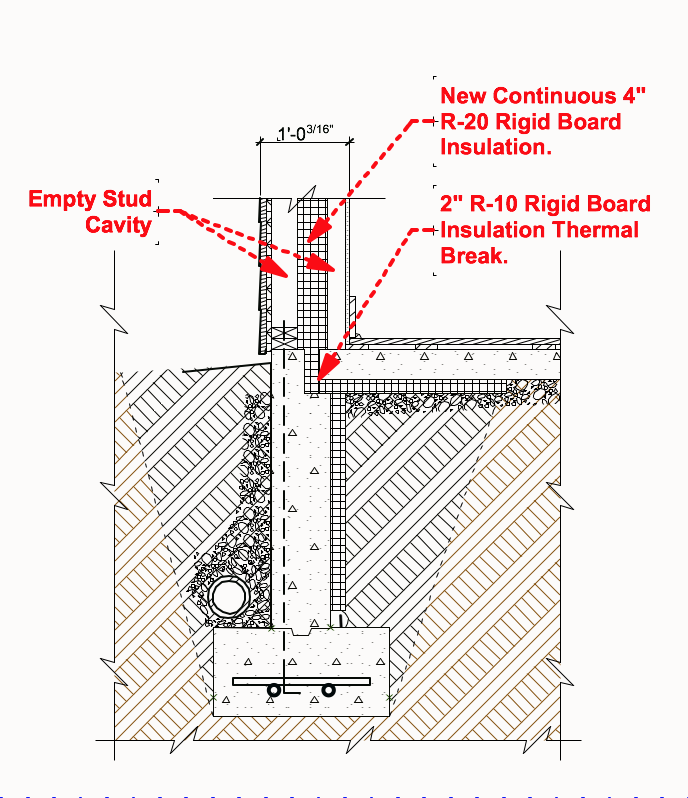
The example we show is a new approach that allows each layer to function independently of the other layers of the wall system. The reason we propose this, is to increase the longevity of the building by making it easier to renovate, and, provide clear demarcations between the trades to help speed up labor.
Type 3 Breakdown of Components
- Structural Layer: we use 2×4’s w/ no insulation. This allows for easier integration of hurricane ties, anchor bolts, etc. without compromising insulation. Because the cavities are empty, air can be circulated to ensure all the wood stays dry.
- Insulation Layer: insulation is in board form and is attached directly to the structure, all the way down to the footing, without interruption. Being continuous, it offers R-20 even over studs and other parts of the structure. This method ensures that all insulation is not interrupted by pipes, runs or structural members. A reflective surface on both sides helps ensure radiant heat doesn’t enter in the summer, or interior heat isn’t lost during the winter. Because the insulation layer is so effective, rough-in plumbing can safely be placed on the exterior wall. Note that the slab is thermally separated from the foundation wall. This break will keep the floor closer to the indoor temperature.
- Finish Layer: wall board is attached to empty 2×3 metal studs, that doubles as a wire chase and space for junction boxes/outlets. Because junction boxes do not interrupt the insulation layer, the home is easier to keep comfortable year around.
Type 3 Cons: Contractors will say this costs more because the foundation wall length is larger, but the reality is the foundation wall is perhaps only 8 inches longer which is hardly worth mentioning. Of course the metal studs will cost, but knowing that the insulation company can get in and insulate the entire house, keeping it warm (or cool) for other workers, and that the electrician has pre-made holes in the studs, makes this a financially sound way to assemble a house.
Type 4: Best Wall Type for All Residential Structures
I’ve often ask myself: “what do I want for the structure of my home?” Well, solid first of all, one that doesn’t creep when heavy winds blow. One that is secure from impact of any kind including wind, one that is easy to keep warm or cool, so that I don’t have to deal with wild indoor temperature changes or hearing a furnace going off every 15 minutes. A house that is quiet. A house that is easy to upgrade. And finally, a house, if purchased used, can be renovated easily. Ultimately I would want the greatest Energy Savings: Best Wall Construction.
This leads me to a minimum 6″ of reinforced masonry to act as structure, with a separate slab-on-grade with a thermal break at the foundation wall. Further, an independent continuous insulation barrier and an independent interior stud wall.
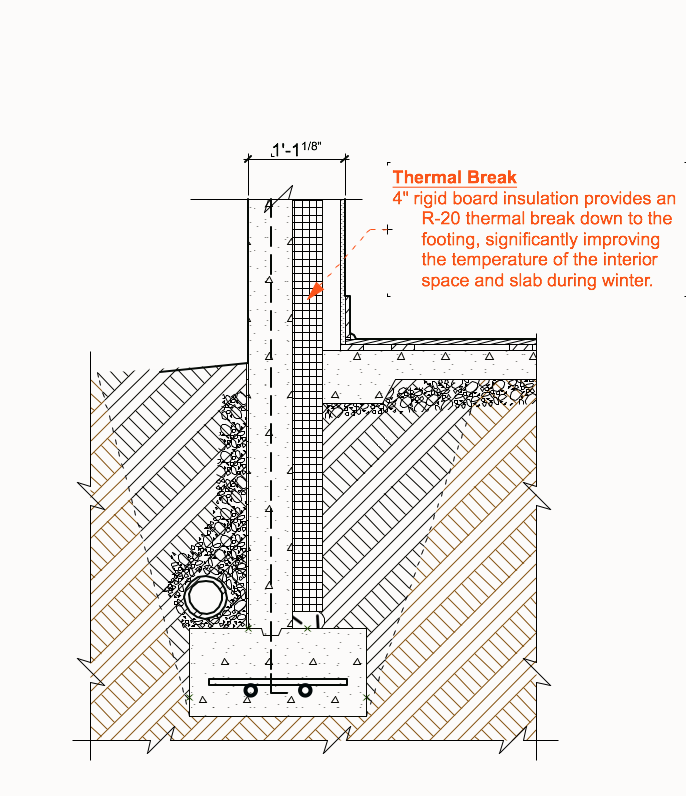
Some of the unsung benefits include: no additional siding work, no termite screed, no sill plate, studs, headers, top plate or pad, no additional hurricane ties for the sill plate/stud wall (although still in use at the roof framing). Further, windows and doors can be secured directly to the masonry, for a more secure fit against wind. With continuous R-20 or greater, plumbing is no problem on exterior walls, as well as any other interior pipes or runs.
Conclusion
When it comes to Energy Savings: Best Wall Construction, Type 4 provides everything a home should have. Strength, noise control, throughly insulated, ease of wall access for wiring. As such, this is the home that will sustain itself for many decades to come.
